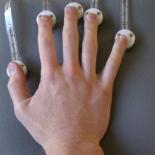Muscle Activity During MRI with FlexiForce
A force sensing device enables researchers to digitally measure force from a human subject’s fingers as they press on the device during an MRI scan.
Studying Muscle Forces in the MRI Environment
Mag Design & Engineering (MD&E) prototypes devices that researchers use to study human brain function and human bone joints. Their services range from computer hardware configuration and assembly to image processing to statistical analysis. MD&E is using FlexiForce™ sensors to record muscle activity and determine the amount of force being sent through a bone joint. For one particular study, researchers needed a device to study muscle control in parts of the brain using functional MRI (fMRI) scanning of brain activity. MD&E instrumented a device with FlexiForce force sensors, enabling researchers to digitally measure force from a human subject’s fingers as they pressed on the device during a brain scan.A core need for an fMRI researcher is to have the subject reliably respond to stimuli in the scanner. The force sensing device developed by MD&E is completely MRI-Safe and extremely comfortable for a long period of use, which is a key element in acquiring accurate data. The design is extremely durable, and adaptable for use with many stimuli-presentation programs. The firm has found FlexiForce sensors ideal for use within the MRI due to their wide resistance range, high linearity, low drift, and low power consumption. In addition, they contain no ferromagnetic material. MD&E interfaces the FlexiForce sensor with a single op-amp to a BX24 microcontroller’s onboard A/D converter. Using a pre-built 5V to -5V converter, they are able to produce the bias drive and negative supply for the op-amp. MD&E then adheres the sensor to the load-carrying surface, and affixes a small rubber puck to the other surface to ensure concentration of the load over the sensor’s active area.
This setup works great, and I have used this system in a number of configurations to measure force from fingers, feet, etc. As far as I know, there is no better force-sensing solution for what I am doing.
Ben Krasnow of Mag Design
Benefits of FlexiForce™ Sensors
- Ultra-thin sensor construction and flexibility means minimal interference/disturbance to normal action
- Accurate response gives your customers and end users confidence in the performance of your product
- Knowledgeable, experienced technical staff help you develop the most effective, economical sensor based on your specific requirements. All manufacturing takes place at ISO 9001 compliant & 13485 registered Tekscan headquarters.
- 100% factory inspection ensures your sensors meet established performance specifications
